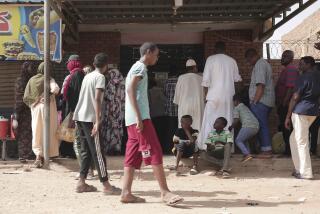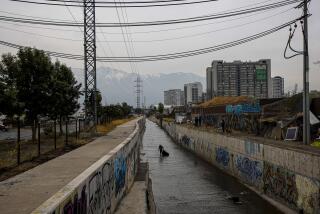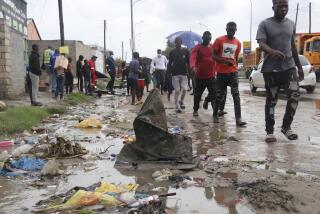Postscript : Colombia’s Cholera Points Up Health Plight of Indians : * The tribes in the southwestern part of the country are vulnerable to a variety of medical problems.
- Share via
LA SIERPE, Colombia — This and other Indian villages on the banks of the Saija River in southwestern Colombia stand as dark omens of what cholera, the deadly bacteria breeding in human waste, holds in store for Indians living all along the country’s Pacific Coast.
Three months ago, cholera attacked La Sierpe and other isolated river communities, producing what was then the highest fatality rate from the disease in Colombia. Many Indians belonging to the Embera tribe died from dehydration caused by uncontrolled diarrhea, cholera’s main symptom.
Though Colombian authorities have succeeded in slowing cholera’s progress in the southwest, the bacteria has underscored the vulnerability of the country’s estimated 400,000 Indians, not just to cholera, but to a wide range of health problems.
Doctors agree that the government reacted quickly to the disease, educating people about its treatment and supplying affected areas with antibiotics and rehydrating solution. But critics say that chronic problems of sanitation and health care remain unaddressed, especially in the isolated Indian villages like La Sierpe dotting southwestern inlets and rivers.
Cholera continues to ravage several such villages, where the fatality rate remains among the nation’s highest. The reason, doctors say, is that the Indians’ tribal customs, combined with their isolation, make timely medical treatment difficult.
The residents of La Sierpe say the tragedy is just another case of the Colombian state’s neglect of the health of the country’s indigenous people.
“We have a medical station here that’s an empty shack without medicine and without a (permanent) doctor,” said Florin Chiripua, the leader of La Sierpe, sitting with other Embera men in a communal house raised on stilts beside the brown river. “Before cholera came, we hadn’t seen a doctor in months.”
As he spoke of the village’s health problems, an emergency team of two doctors and two nurses treated some of the sick. The team and an administrator were on a 15-day mission to the zone’s Indian villages as part of a $14,000 project financed with public funds from a Cauca state development corporation. The project was initiated after cholera swept through the region in April and May.
“The problems with cholera opened the way for these people to receive temporary medical treatment that they have lacked for years,” said Adolfo Orosco, a 28-year-old doctor working on the project. “The problem is that once we leave, they will be left totally unprotected once again.” People are dying, Orosco said, “not only of cholera but of abandonment” by the authorities.
La Sierpe is not unique. The medical project’s administrator, Grace Gallego, said her team had not found a single doctor or nurse in their tour of the region’s river communities. Nor do any of the villages have sewage disposal systems or aqueducts to provide fresh water.
“These villages use the rivers as their bathrooms and as their sources of drinking water,” she said. The practice opens the way for cholera infections when people come in contact with waste containing the bacteria.
Officially, 23 of the 511 inhabitants stricken with cholera in the region have died from the illness. The majority were Indians either unable or unwilling to receive treatment at a medical center. Unofficially the number of deaths is much higher, health workers say.
“Hospital statistics do not reflect reality because many Indians who die without ever making it to a health station do not appear in the official count,” Gallego said. “We’ll never know how many people in Saija the disease has killed.”
Transportation problems hamper efforts to aid the Indians. Some of the region’s rivers rise and fall along with the ocean tides, and many of them dry up when the heavy rains on the coast diminish for even brief periods.
“The difficulties of transport along the Saija River are tremendous,” said Cecilo Gongora, the owner of a small boat at Puerto Saija, about five miles down river from La Sierpe. “Even if people have a canoe, they usually have to drag it across the dry parts. If a person has cholera, it’s almost impossible to get him down river.”
It took the medical team four days of rowing and hiking to reach several isolated Embera villages up-river. There they found not only cholera but also cases of malaria, amoebic dysentery and pneumonia. At least seven Indians were near death, Orosco said.
When cholera first struck the region in late April, many Embera, faced with daunting transportation problems, chose treatment by their village’s traditional doctor or jaibana (literally, a “man of the spirits”).
A jaibana treats sick patients by drinking pilde , a fermented beverage, falling into a trance and communicating with spirits that he believes tell him the nature of the illness and how to cure it. Plants and other natural medicines commonly used are worthless in the treatment of cholera.
“Many of the Indians who died from cholera sought treatment from their jaibana, “ said Ophelia Baltan, a nurse living in Guapi who has made several trips up-river. “I have to work hard to persuade a lot of Indians to see a real doctor.”
Cholera claimed at least two lives in La Sierpe. Said Dario Chichliana, the son of one of the victims: “My mother was vomiting for a day and a half before she died, but we didn’t know about cholera then and so we didn’t take her to a doctor.”
Other Indian villages are learning the same tragic lesson. Most recently, cholera has moved north from Narino and Cauca states and attacked communities in Choco state, home to 35,000 of Colombia’s estimated 400,000 Indians.
The government has already reported 211 cholera cases and 20 deaths from the illness in Choco; the regional Embera-Waunana tribal council says its count includes 36 dead in the state.
“The same problems are now being faced in Choco that were faced here in Cauca because in both states there are isolated Indian communities especially vulnerable to cholera,” said Espinosa in his office in Guapi.
Eduardo Mallaga, a former president of Choco’s Embera-Waunana council, said the government neglect of Pacific Coast Indians is now being felt most acutely in the state.
“The government has now sent a few doctors to help our people,” Mallaga said in a telephone interview from the council offices in Quibdo, the state’s capital. “If it wasn’t for cholera, there wouldn’t even be such minimal medical attention.”
Mallaga and others say they hope the illness will serve as a reminder to the government that many native Colombians lack basic health care.
The Colombian Health Ministry has spent more than $3 million on its cholera education campaign, which officials say has reduced the disease’s toll. Another $19.6 million has been budgeted for a long-term project to improve aqueducts and sewers on the Pacific Coast, Colombia’s poorest region and the focal point of its cholera epidemic.
Initial projections said Colombia could suffer as many as 30,000 cases of cholera by the end of the year. But government officials, saying the epidemic is spreading much more slowly than expected, have revised the figure to as few as 15,000 cases. That compares to more than 200,000 cases already reported in Peru, where the bacteria is most widespread.
“We’re seeing the result of a very effective education campaign,” said Antonio Iglesias, the director of Colombia’s National Health Institute, in an interview in his Bogota office.
Iglesias pointed as signs of the government’s success to two port cities in the southwestern coastal area where the disease is concentrated. The cities, Tumaco and Buenaventura, account for 2,703 of Colombia’s 4,252 official cases but only 12 of the 76 reported deaths from the bacteria, he said.
Cholera is treatable with rehydration solutions and antibiotics that are in plentiful supply in government medical centers. Information about prevention is readily available in population centers like Guapi, a river port of 6,766 people 30 miles southwest of La Sierpe. Buildings lining Guapi’s main dirt street are covered with government posters advising people to avoid cholera by boiling water and avoiding uncooked food, especially fish.
The campaign has apparently worked. The average number of cholera patients receiving treatment at the Guapi hospital has dropped from 13 on a day in late April to the current one or two a day. A visiting reporter found the hospital’s cholera ward empty except for an elderly man who had entered that morning after a night of intense diarrhea.
Doctors say cholera cases have also dropped at La Sierpe and other Indian villages on the Saija River after months of deadly infections. But Orosco and other doctors say cholera is likely to plague Colombia’s Pacific Coast for years to come.
“It’s a problem that won’t be solved by a few health brigades,” he said. “It won’t be solved until the government provides basic services to the communities in this region.”
Cholera: The Spreading Disease More than 30 countries around the world have reported some incidence of cholera. A severe epidemic of cholera broke out in Peru at the end of January. Since then it has spread to Ecuador, Colombia, Chile, Brazil, Guatemala and Mexico. As of the end of July, more than 260,000 cases and more than 2,900 deaths had been reported. The epidemic has raised concerns for the health of Indians in towns like La Sierpe, Colombia. COUNTRIES REPORTING CHOLERA Angola Benin Brazil Burundi Cameroon Chad Chile Colombia Ivory Coast Ecuador Ghana Guatemala Guinea India Indonesia Iraq Kenya Liberia Malawi Mali Mauritania Mexico Mozambique Nepal Niger Nigeria Peru Sao Tome & Principe Tanzania Togo Vietnam Zaire Zambia Source: The Centers for Disease Control, an arm of the U.S. Public Health Service
More to Read
Sign up for Essential California
The most important California stories and recommendations in your inbox every morning.
You may occasionally receive promotional content from the Los Angeles Times.










